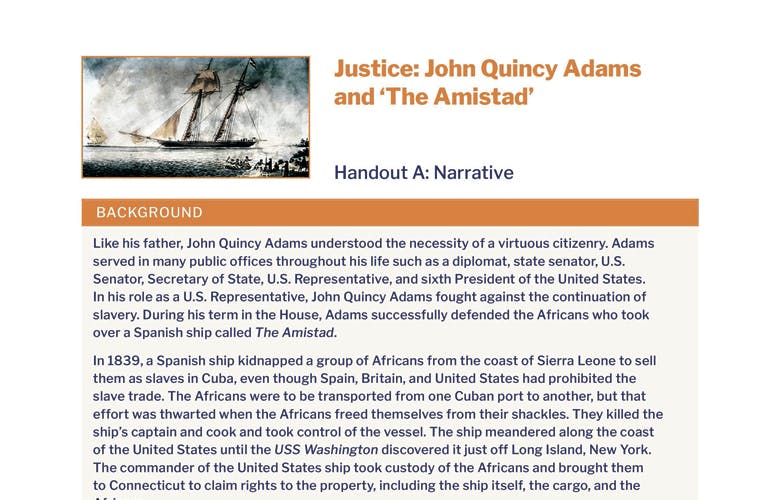Justice: John Quincy Adams and The Amistad – Handout A: Narrative
BACKGROUND
Like his father, John Quincy Adams understood the necessity of a virtuous citizenry. Adams served in many public offices throughout his life such as a diplomat, state senator, U.S. Senator, Secretary of State, U.S. Representative, and sixth President of the United States. In his role as a U.S. Representative, John Quincy Adams fought against the continuation of slavery. During his term in the House, Adams successfully defended the Africans who took over a Spanish ship called The Amistad.
In 1839, a Spanish ship kidnapped a group of Africans from the coast of Sierra Leone to sell them as slaves in Cuba, even though Spain, Britain, and United States had prohibited the slave trade. The Africans were to be transported from one Cuban port to another, but that effort was thwarted when the Africans freed themselves from their shackles. They killed the ship’s captain and cook and took control of the vessel. The ship meandered along the coast of the United States until the USS Washington discovered it just off Long Island, New York. The commander of the United States ship took custody of the Africans and brought them to Connecticut to claim rights to the property, including the ship itself, the cargo, and the Africans.
It has been said that there are two sides to every story, but in this situation, there were at least five sides. The case was first brought to the United States District Court when the commander of the Washington filed a suit to claim the Africans and cargo. Two of the masters on the Amistad filed suit to have the Africans and cargo returned to them. However, the United States Attorney for the District of Connecticut filed suit to have the property returned to the Spanish government. The Africans themselves maintained that they were not property or slaves and could not be returned to any owner. There was even more contention when President Martin Van Buren ordered that the Africans be returned to Cuba despite the continued appeals in the case. Some viewed the president’s order in the complex case as an overreach of executive power.
In the ruling, the district court ordered that the Africans be returned to Africa under the protection of the president and did not award them to the Spanish government. It ruled that the commander of the USS Washington be awarded one-third of the ship’s property and the shipmasters also be awarded one-third of the ship’s property. Under an order by President Van Buren, the case was appealed to the circuit court that upheld the district court’s finding. The case was then appealed to the United States Supreme Court.
Adams delivered an extensive defense of the Africans, citing the prohibition of the international slave trade. He insisted that the people on board the ship were not property but were free people. He also argued that the executive branch should not have been involved in the case.
NARRATIVE
Former president John Quincy Adams entered the Supreme Court chamber to deliver closing remarks in a contentious case. Adams was serving in the House of Representatives when he volunteered to be part of the defense team for the thirty-six Africans who took over a Spanish ship called The Amistad after being captured illegally in Africa to be sold in Cuba.
After he accepted the case, Adams was extremely nervous. He made a careless mistake and lost his temper in a debate in the House when he ranted against Congressman Henry A. Wise of Virginia. Adams and Wise were rivals in the House and regularly disagreed about issues of slavery. Adams was appalled by his own behavior and continued to lament his actions. Because of his nerves and embarrassment about the situation, Adams had asked his colleague Roger Baldwin to make the opening statements before the Supreme Court.
The next day, John Quincy Adams stood to address the justices in the closing argument for the defense. Adams focused his eight hour-long speech on moral and judicial principles surrounding the case. His main concern was that the Africans, who stood to lose the most from the Court’s decision, would maintain their liberty and find justice. Adams reminded the Court that their purpose was to protect justice, which he defined as “the constant and perpetual will to secure to one his own right.” He explained that the lives and liberties of each of the thirty-six Africans depended upon the decision of the Court.
Adams believed that the government had not protected the rights of the Africans. The United States Navy had no warrant to seize the Africans’ ship, nor did President Martin Van Buren and his administration have the right to get involved in a court case because of the separation of powers between the branches of government. Adams adamantly argued that the Supreme Court was part of the judicial branch and not the executive branch, and that the Court was not under the power of the president or his administration. According to Adams, not only had the president overstepped his constitutional bounds, but he put the lives and liberties of the Africans at risk in doing so.
Adams’ impassioned defense led all but one of the Supreme Court justices to agree with him. The Africans were freed and allowed to return to their homes. In 1842, after raising the funds necessary for travel, the thirty-six Africans returned to Africa. Adams’ valiant fight for justice did not end there—the man who hired him to assist on the case never received a bill for Adams’ service.
